The Ultimate Guide to Pool Water Chemistry
Owning a pool is a luxury, but maintaining one? That’s where the real work begins. Beyond just keeping your water clear, maintaining proper pool water chemistry is essential to swimmer safety, equipment longevity, and long-term enjoyment. Whether you’re a seasoned pool pro or new to pool ownership, understanding the basics can help prevent costly repairs and keep your pool swim-ready all year long.
In this comprehensive guide, we’ll break down every critical aspect of water chemistry from testing methods and pH balance to shocking procedures, sanitizer options, and algae prevention. If you’ve ever struggled with cloudy water, mysterious stains, or algae outbreaks, this guide is for you.
Why Pool Water Chemistry Matters

A comprehensive water chemistry system must be maintained to assure crystal clear, sparkling water. Water is rarely free of harsh minerals and other invaders, such as bacteria, living organisms, ammonia, and other contaminants. Other factors, such as climate, weather, bather load, and poor water chemistry, will add these invaders to your pool. Certain chemicals have to be added to your pool to combat the undesired effects of these invaders.
To achieve and maintain balanced water chemistry, you must know how to test for and adjust the pH, alkalinity, and hardness levels of your water. You must also know how to test for and adjust chlorine (or bromine) levels. Chlorine will sanitize, disinfect, and oxidize your water. Its job is to kill all bacteria and algae and combine with ammonia and other contaminants in your pool. Due to the presence of ammonia, regular shocking is also necessary.
The first year or two of operation are the easiest because minerals haven’t yet had a chance to accumulate, but as the pool water ages, testing becomes more critical. Preventing problems before they start is far less costly than after-the-fact remedy. By far, the most common problem with pool chemistry that any pool owner has to deal with is when the pool simply runs out of chlorine. Your pool without chlorine will sooner or later turn cloudy and green. This might cost you some swimming time during our short summers, but many times can be rectified easily.
The most dangerous mistake is not paying attention to the pool water balance. Since unbalanced water becomes aggressive, it will attack the pool itself and, over the years, it will depreciate your backyard investment without you even noticing it.
CHEMICALLY TREATING NEW AND REFILLED POOLS
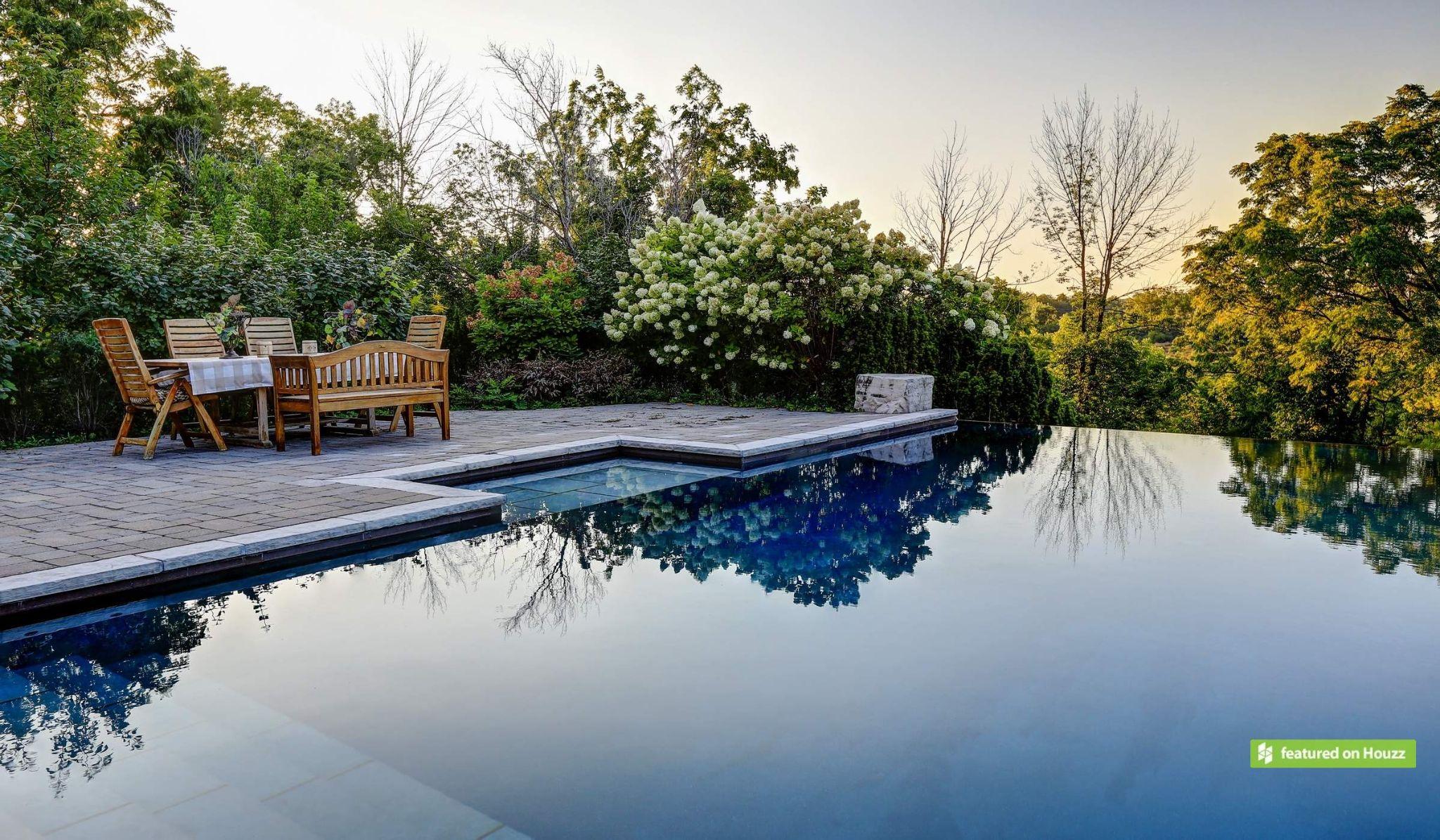
It may surprise you, but the water you drink may not be suitable for your pool. Tap water can have high or low pH and mineral levels that can harm your pool. Improper pH and mineral levels can also prevent pool treatments from working. So even if you fill your pool from the tap, it must be chemically balanced.
It is a good idea to have your water balanced at the beginning of the pool season, or when it is filled.
Freshly marbelited pools are filled immediately with water to allow the marbelite to cure for about 6–8 weeks. While curing the pool’s pH, water will be drifting up, and it will need to be continuously and frequently adjusted.
1. CHEMICAL TESTING

All appropriate treatment programs for your pool begin with accurate testing. Different chemical factors and parameters must be tested to verify that proper ranges are being maintained to ensure properly balanced and sanitized water.
IDEAL RANGES OF CHEMICAL LEVELS IN POOL WATER
| Chemical | Minimum | Ideal | Maximum |
| Chlorine | 1.0 ppm | 2.0–3.0 ppm | 3.5 ppm |
| Cyanuric Acid | 20 ppm | 30–50 ppm | 100 ppm |
| Bromine | 2.0 ppm | 2.5–4.0 ppm | 5.0 ppm |
| pH | 7.2 | 7.4–7.6 | 7.8 |
| Alkalinity | 70 ppm | 80–140 ppm | 150 ppm |
| Calcium Hardness | 150 ppm | 200–450 ppm | 500 ppm |
| Total Dissolved Solids | 400 ppm | 1500–3000 ppm | 3500 ppm |
| Copper | 0 | 0 | 0.1 ppm |
| Iron | 0 | 0 | 0.1 ppm |
TEST STRIPS
Test strips are paper strips that contain dyes which will change colour once added to your pool water. These colours will correlate with a colour chart on the bottle indicating whether a chemical is low, in range, or high. Most test strips will test for (1) your chosen sanitizer/disinfectant/oxidizer, (2) the pH, and (3) the Alkalinity. These are the three main areas that must be tested regularly at the poolside.
TEST KITS
Test kits utilize a test block that holds pool water. The test solutions (reagents) or tablets are added to the enclosed pool water. Many test kits only test for your chosen sanitizer/disinfectant/oxidizer and the pH. By comparing the colour of the water with the colour chart on the test block, you can easily determine the level of the tested chemical as either low, in range, or high.
TESTING TIPS
- Be sure to read the instructions that come with each test kit.
- Perform your chemical tests regularly and always before adding any chemicals to water.
- Reagents have a short shelf life and should be replaced every season.
2. POOL WATER BALANCE
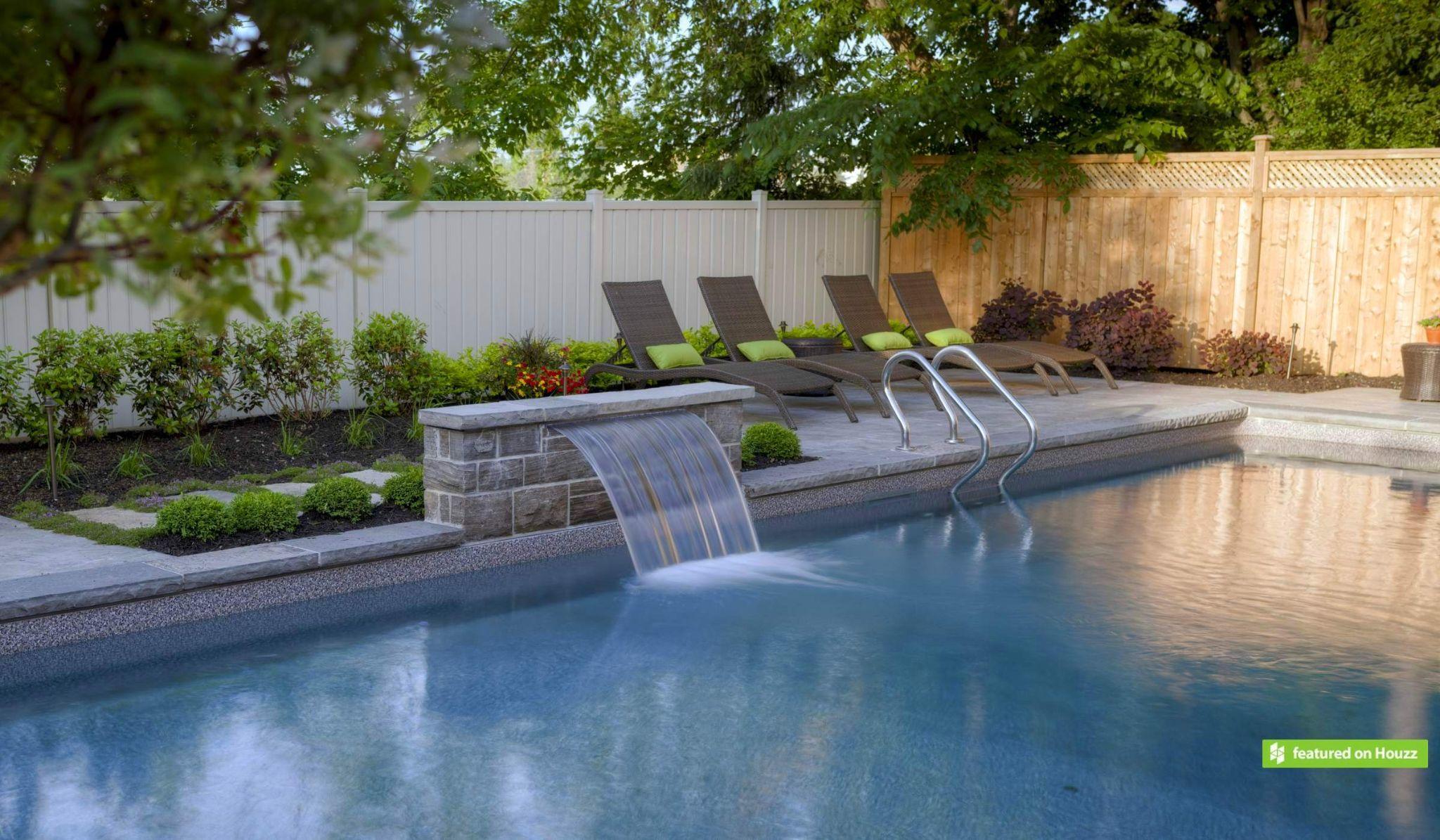
You should be aware of the damage that water can cause when in contact with concrete, grouting, marbleite and metals. Water that corrodes or is scale-forming is called unbalanced, while water that causes no damage is called balanced. Corrosive water is “aggressive” and attempts to dissolve concrete and destroy metal components such as heat exchangers. A tell‑tale sign of corrosive water is staining, the deposit on the pool’s surface of colored metal salts of iron or copper. Scaling water does the opposite – it attempts to deposit or precipitate calcium carbonate out of solution, causing unsightly deposits on pool surfaces, and possibly plugging the filter and circulation piping.
You aim to keep pool water in balance to avoid unnecessary and costly repairs. You are protecting your investment by ensuring your pool water is balanced. Limited Manufacturer’s Warranties will not cover your equipment for damage caused by unbalanced, aggressive pool water.
PARAMETERS OF WATER BALANCE
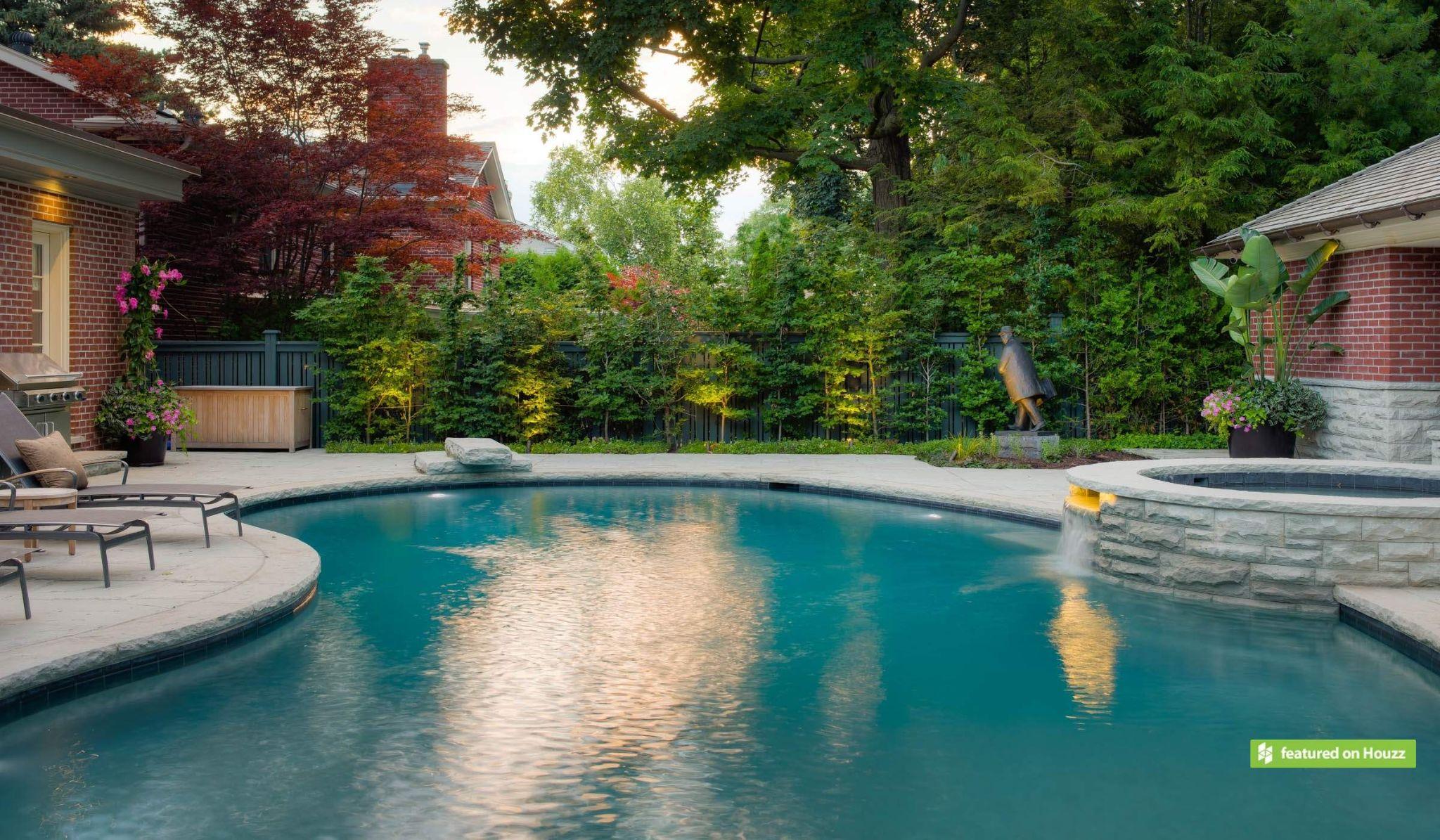
- pH
- CALCIUM HARDNESS
- TOTAL ALKALINITY
- TOTAL DISSOLVED SOLIDS
When all four of these are within the desired range, the water is gentle on swimmers, easy on the pool surface, kind to the pool equipment, and the sanitizer is used efficiently. It is crucial to have all of the above‑mentioned parameters in the proper range because when one or more factors are below or above the appropriate range, the water will corrode or scale even though the remainder are in the proper range.
Of equal importance to adjusting these factors is the sequence of such adjustments. Irrespective of the pH or calcium hardness readings, total alkalinity is the FIRST parameter to be corrected. Next in sequence is calcium hardness, followed by pH.
I. pH
Ideal range: 7.4 to 7.6
pH is the primary component of water balance. A properly maintained pH will help ensure swimmer comfort, prevent deterioration of the pools’ surface and equipment, maintain clear sparkling water, and guarantee the effective use of sanitizer and oxidizer. The pH scale to determine a liquid’s acidity ranges from 1.0 to 14.0, with 7.0 being neutral. Any number below 7.0 represents an acidic condition of water, and any number above 7.0 represents an alkaline (or basic) condition of water. Although 7.0 is ideal for everyday water, for a swimming pool, the perfect pH range is slightly alkaline, in the range between 7.4 and 7.6. This assists bather comfort, as the pH of the human eye is about 7.5.
HIGH pH
If a pH test shows a pH level of 7.8 or higher, the pH must be lowered. Two chemicals can lower the pH. The first is a granular product, and the second is Muriatic Acid.
Problems Associated with High pH Levels
- Cloudy water
- Scale formation on the pool walls, floor, plumbing, pumps, filter and heater.
- Poor chlorine (or its alternative) efficiency – The high level of pH actually deteriorates the chlorine before it can engage in its intended purpose.
- Eye and skin irritation
BioGuard Lo’N’SLO – is a dry granular chemical ideally suited for lowering the pH of swimming pools slowly. It is a concentrated product that is safer to handle than liquid acids.
LOW pH
If a pH test shows a pH level at 7.2 or below, then the pH must be raised.
Problems Resulting from Low pH
- Corrosion – metallic parts of your pool will dissolve (walls, floor, handrails, ladders, light fixtures and equipment). This could lead to discoloured water and permanent stains on the pool walls and floor.
- Stained and etched plaster in gunite or shotcrete pools.
- Stained and wrinkled liner in vinyl‑liner pools.
- Eye and skin irritation
BioGuard BP 200 – is a premium-grade dry powder chemical ideally suited for slowly increasing the pH of swimming pools. It is entirely soluble, so it will not cloud your pool water.
II. Alkalinity
Ideal range: plaster pools 80 – 125 ppm | vinyl pools 125 – 150 ppm
While Alkalinity has a definite impact on pH, it is not the same as pH. Alkalinity helps a body of water stabilize its pH level and hold it in its range. Total Alkalinity is a measure of the ability of water to resist changes in pH. It is often called a “pH buffer”. In a pool with low alkalinity, pH can wander dramatically. This is called pH bounce. The result is a highly unbalanced water condition that damages pool equipment and pool surfaces. If the Alkalinity is low but the pH is in range (7.2‑7.8), an alkaline material still must be added to the water to bring the Total Alkalinity level to its ideal range.
LOW ALKALINITY
If your Alkalinity level is too low, the pH will fluctuate dramatically, making it impossible to maintain it in the proper range. Without Alkalinity in its appropriate range, the pH of the water will fluctuate and cause damage to the pool and equipment. You must test your alkalinity levels weekly and determine how much they need to be raised. Following the manufacturer’s specifications, you can decide how many pounds of Alkalinity Increaser (Sodium Bicarbonate) to add to get your Alkalinity in the ideal range.
BioGuard BP 100—This premium–quality granular product is easy to use. It is always added directly to pool water to raise Total alkalinity. 180 g of Balance Pak 100 per 10,000 litres raises total alkalinity 10 ppm. It dissolves quickly and will not cloud water.
HIGH ALKALINITY
If your Alkalinity is too high, the pH will be difficult to adjust. The two chemicals commonly used to lower Alkalinity are those that lower pH: Sodium Bisulphate (BioGuard Lo’N’SLO) or Muriatic Acid. However, since the Alkalinity of the pool water naturally goes down over time, if the pH is in the proper range over time, the Alkalinity will eventually drop to its proper range.
III. Calcium Hardness

Ideal range: plaster pools 200 – 275 ppm | vinyl pools 175 – 225 ppm
Hardness measures the amount of calcium, magnesium and manganese that are present in the water. The acceptable range for hardness runs from about 150 ppm to 450 ppm. Of the three primary minerals measured under Hardness, calcium is the most significant mineral, since magnesium does not form scale.
Pools with too much calcium may scale, but pool water deprived of calcium becomes aggressive and seeks to dissolve calcium from any contact source, such as grouting or concrete surfaces. Most anything can be dissolved in water if given the right conditions. The role of Calcium in water balance is to feed the aggressive nature of water to prevent it from eating away at the surface and equipment. If Calcium is maintained too high, the excessive Calcium will come out of solution, causing scale to form in heaters, filters, plumbing and on the pool surface. Seasonal temperature changes also alter the water’s need for Calcium. Water requires less Calcium in warm water than it does in cold water. Adjust Calcium Hardness after first adjusting the Total Alkalinity. Then, balance Calcium Hardness within the proper ranges depending on the pool’s surface. The pH should be adjusted last.
Pool owners need to maintain sufficient calcium in their pool to achieve water balance. Hardness should be tested for once per month. If you are experiencing problems with dissolved metallic parts in your pool, discoloured water, stains, or scale formation, we advise you to have your hardness level professionally tested.
LOW HARDNESS LEVEL
If your Hardness reading is below 150 ppm, you’ll need to add Calcium Chloride to the pool water.
BioGuard BP 300 – High-quality calcium hardness increaser in granular form is applied directly to pool water with the pump and filter running. Do not pre‑dissolve and never use this product through the skimmer. 100 grams of BP 300 per 10,000 litres of water raises calcium hardness by approximately 10 ppm. Add 1/3 of the total treatment every six hours.
HIGH HARDNESS LEVEL
If your Hardness level is too high (over 500 ppm), you must drain your pool, wholly or partially. There is no chemical to lower the Hardness level. Once refilled, it is then necessary to rebalance the water chemistry. However, BioGuard SCALE INHIBITOR will prevent calcium from depositing on pool walls and inside the equipment by destroying its scaling capabilities.
IV. Total Dissolved Solids (TDS)
Suggested range: 1500 – 2500 ppm
Total Dissolved Solids (TDS) measures the amount of minerals, chemical residue and other particles in water. Water evaporation is the primary factor that leads to TDS. As water evaporates, the chemicals stay in your pool. This matter accumulates over time and acts as a sponge, consuming your chemicals and rendering them virtually ineffective. In a swimming pool, it will take approximately 6 to 8 years for the TDS reading to become so high that it will consume your chemicals. High TDS water has an increased tendency to corrode. Most pool and spa water has TDS readings lower than 2000 ppm, which has little effect on water balance.
Tap water used to fill your pool typically has a TDS reading of approximately 300 ppm. Chemicals, other undissolved matter and evaporation add approximately 450 ppm of TDS to your pool annually. Once TDS reaches its maximum parameters, drain the pool–wholly or partially–and start fresh.
Certain indicators may tell you that your TDS reading is too high:
- Continual addition of excess chemicals.
- Water chemistry tests fine, but water is still not clean, clear, blue and sparkling.
- Colored yet clear water (water has an odd tint, but the floor is still visible).
- Algae growth despite a good chlorine reading (or its alternative) and proper water chemistry.
- Varying and false readings on chemical tests.
If any of these are the case with your pool, the TDS levels may be the problem. Again, you can only lower TDS by draining the pool, partially or entirely. Call us to have your pool professionally drained and cleaned; it is an investment and money well spent.
V. Temperature
At ordinary pool water temperatures hovering around 78° to 82°F (25° to 28°C), temperature is not a significant factor in balancing water. The temperature factor becomes noticeable only at the extremes of spa water (104°F or 40°C) and water in a winterized pool. High-temperature water tends to scale, and cold water corrodes more than standard pool water.
3. SANITIZERS – CHLORINE

Ideal range of Free Chlorine: 2.0 – 3.0 ppm
Chlorine sanitizes, disinfects and oxidizes water. Without chlorine in your pool water, the pool will not stay blue, clear and sparkling for too long. After some time, you can tell just by the look of your pool that chlorine needs to be added.
By sanitizing, chlorine will reduce the level of micro‑organisms by significant numbers (usually 99.9 % or more) to safe levels. Chlorine will destroy all potential disease‑carrying capabilities of these bacteria, algae, fungi and viruses, thereby disinfecting your pool water. Most organisms are harmless to the human body, but some are disease and infection‑causing. These “germs” are transmitted via water to other bathers if not killed.
By oxidizing, chlorine will “burn up” organic contaminants introduced into the water by the bather. The organics, such as hair spray, deodorant, suntan lotion, body oils, microscopic skin particles, perspiration, urine, etc., contaminate pool water. Organics cause pool water to be dull, listless, and cloudy. Addition of high levels of chlorine, called super chlorinating or shocking, allows much of these organics to be oxidized (or burned up) into dissolved solids and gases such as nitrogen, leaving the water sparkling and inviting. This is why you must shock your pool water regularly. Only 10% chlorine is needed for sanitation, while the remaining 90 % is used for oxidation.
The chlorine level must be closely watched, as it will fluctuate due to climate and bather load, and the constant introduction of bacteria, living organisms, ammonia and other contaminants to your pool water by rain, wind and the human bather that will consume chlorine. Chlorine will combine with bacteria, algae, ammonia and other chemicals. This is why chlorine levels must be tested and adjusted regularly (minimum once a week if you have an automatic chlorine feeder) and more often during periods of direct sunlight and after any rainfall or heavy bather loads.
A minimum reading of 1.0 ppm of chlorine combats algae and bacteria in the water. Below this reading, bacteria will grow. To maintain this level, chlorine should be added according to the results of your test kit. Filling an automatic chlorinator once a week will usually help maintain the desired Free chlorine level in the pool water. The amounts of chlorine added will depend on the type, pool use and weather. As a rule of thumb, an average-sized pool with average use and balanced water during a week will need approximately 1 kg of stabilized chlorine sticks or pucks. However, this is only a rough estimate, and the chlorine demand will fluctuate during the season.
There are numerous alternatives to chlorine on the market. A few candidates attempting to capture a portion of chlorine’s market share are bromine (read BROMINE SANITIZERS later), Baquacil, Mineral Systems, chlorine generators, iodine, and fluorine. Ozone is a supplement to be used with chlorine (or bromine) – it is not an alternative to be used alone; ozone only reduces the pool water’s need for chlorine.
Reactions of Free Chlorine
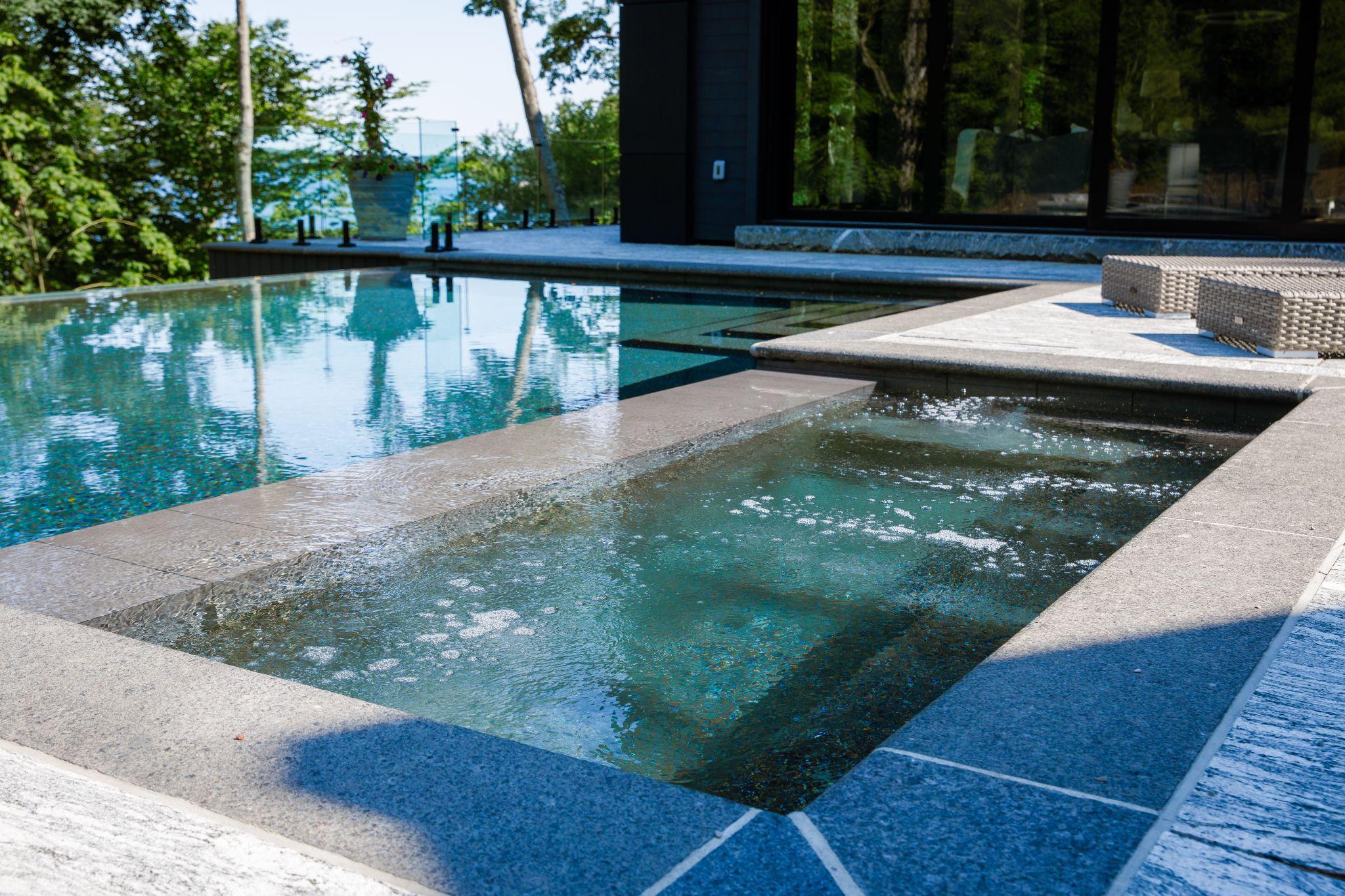
All chlorine sanitizers have one common property – when added to the water, all these chlorine products produce hypochlorous acid (HOCl). Free Chlorine is the amount of Hypochlorous acid in the water. It sanitizes and disinfects by killing bacteria and algae and oxidizing organics. Even at 10‑20 ppm levels, Free chlorine has no detectable smell and causes no irritation. There are four main reactions of Free Chlorine that affect pool sanitation.
- Reaction of Chlorine with Bacteria
When killing bacteria or oxidizing organics, hypochlorous acid loses its properties and becomes an ordinary chlorine ion [Cl‑]. In other words, hypochlorous acid (active chlorine) is reduced to an inactive chloride (salt) when doing its job. - Reaction of Chlorine with Ammonia
Ammonia is one of the end products of the body’s metabolism from ingesting proteins. The reaction of free chlorine with ammonia produces chloramines or combined chlorines. Chloramines cause the characteristic “chlorine odour” of heavily used pools, which can be noticed at levels as low as 0.2 ppm. These irritate the eyes and mucous membranes and are often confused with pool chlorine; however, it is “used up chlorine” that you smell and cannot kill bacteria.
It is necessary to destroy high levels of combined chlorine (more than 0.2 ppm) by breakpoint chlorination. This breakpoint chlorination is achieved by shocking (or superchlorinating) your pool water. The chlorine levels are dramatically increased to 5‑15 ppm in a short period of time. This high chlorine level literally “scours” the pool of oxidized organic matter rapidly and usually results in a clean, sparkling pool. - Destruction of Free Chlorine at High pH
Hypochlorous acid will break up into the hydrogen ion [H+] and the hypochlorite ion [OCl‑]. This ion has only 1 % of the bacteria‑killing ability of HOCl. In other words, hypochlorous acid exists in a killing form and a non‑killing form. The proportion of these forms is determined by the pH of the water. As the pH decreases, chlorine’s killing ability decreases, and the presence of bacteria increases dramatically. This is why pools with high pH have more difficulty with algae and bacteria. At a pH of 8.0, only 22 % of the chlorine is in its killing form compared to 50 % at a pH of 7.5, which is ideal. - Destruction of Free Chlorine by Sunlight
Hypochlorous acid is reduced to salt by the sun’s ultraviolet rays (not heat) in the presence of sunlight. On a bright, sunny day, 90 % of the active chlorine can be destroyed by sunlight within two hours if the pool is not stabilized. This process can be slowed down by using stabilized chlorine and maintaining proper stabilizer levels in your pool.
4. CHLORINE STABILIZATION
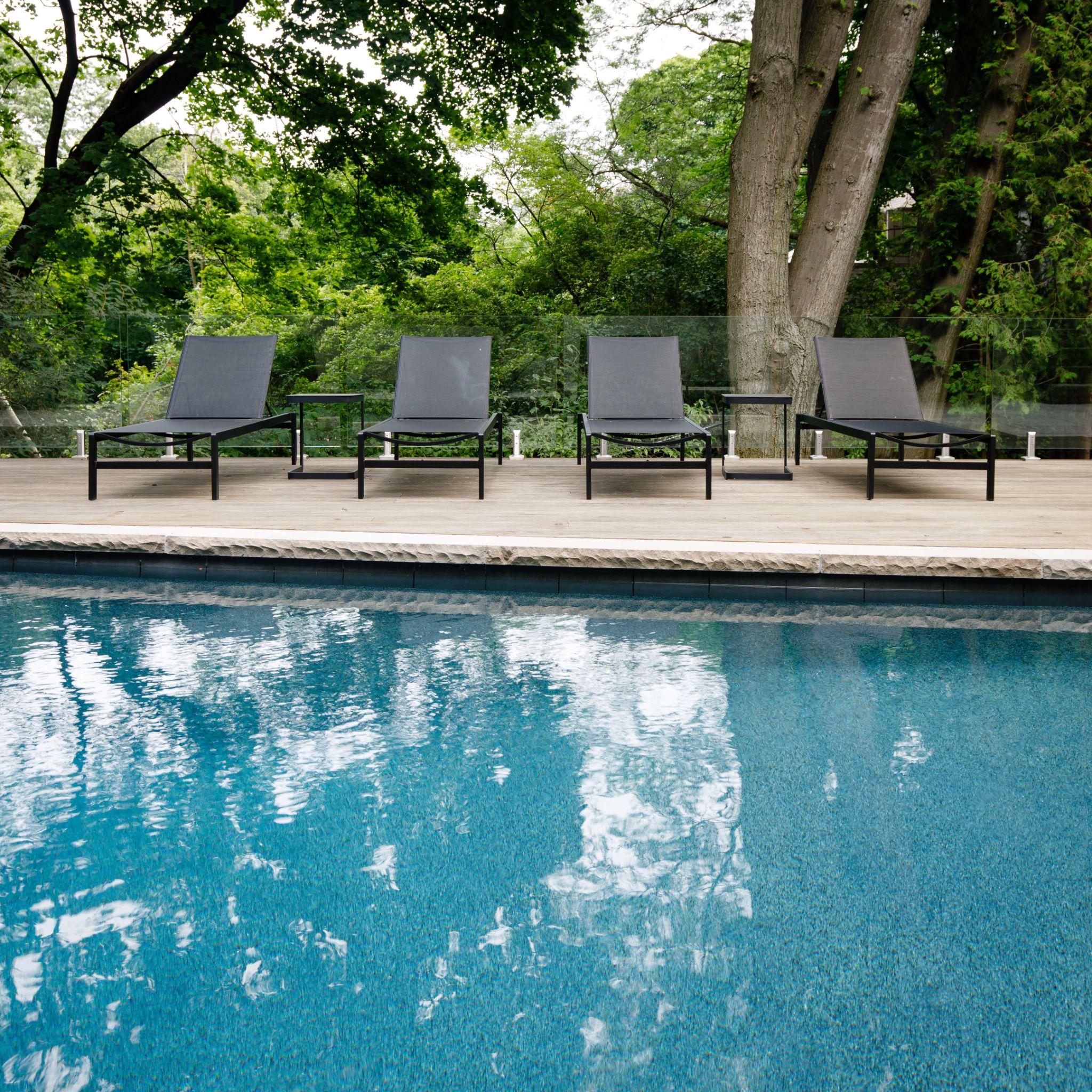
Ideal stabilizer range: 30 – 50 ppm
Chlorine tablets, pucks or sticks are the most commonly used forms of chlorine. These solid chlorine products are classified as Stabilized Chlorine, which contains some Cyanuric Acid as part of their makeup. The amount of stabilizer in the stabilized chlorine is meant to offset the losses of stabilizer through backwashing of your filter and water carryout, so stabilizer will need to be added to new pools after a pool is drained, cleaned, and refilled.
Cyanuric Acid (Stabilizer) dissolved in pool water protects free chlorine from being destroyed by the sun’s ultraviolet rays too fast. Cyanuric acid will stabilize and free chlorine regardless of the chlorine sanitizer used. An unstabilized pool (with inadequate stabilizer levels) will lose half of its available chlorine every 35 minutes. In a stabilized pool (with stabilizer levels from 30 to 50 ppm), free chlorine is protected from the sun’s UV rays by stabilizer, which would last three to five times longer than pool water not containing cyanuric acid. The acceptable range for Cyanuric Acid is 30‑80 ppm. We recommend a reading closer to 40 ppm. It is an excellent idea to get the stabilizer level checked at least at the beginning of the season. If your stabilizer level is too low, your pool chlorine level will be harder to maintain in the proper range, and you will use a lot more chlorine to keep your pool sanitized. Also, test your pool water for Stabilizer levels if you struggle to obtain a sufficient chlorine reading.
After the chlorine portion of the stabilized chlorine has been depleted during sanitation, the stabilizer content of the original sanitizer stays intact. It remains dissolved in the pool water and accumulates. There is no chemical to reduce Cyanuric Acid. It can only be reduced by either partially or completely draining the pool. High stabilizer levels are not recommended due to unknown health risks and could cause permanent cloudiness.
BioGuard Stabilizer 100—Since stabilizer dissolves very slowly, it should always be added through a skimmer. It will find its way through your circulation system into the filter, where it will slowly dissolve. Therefore, do not backwash your filter after adding stabilizer.
Stabilized Chlorines
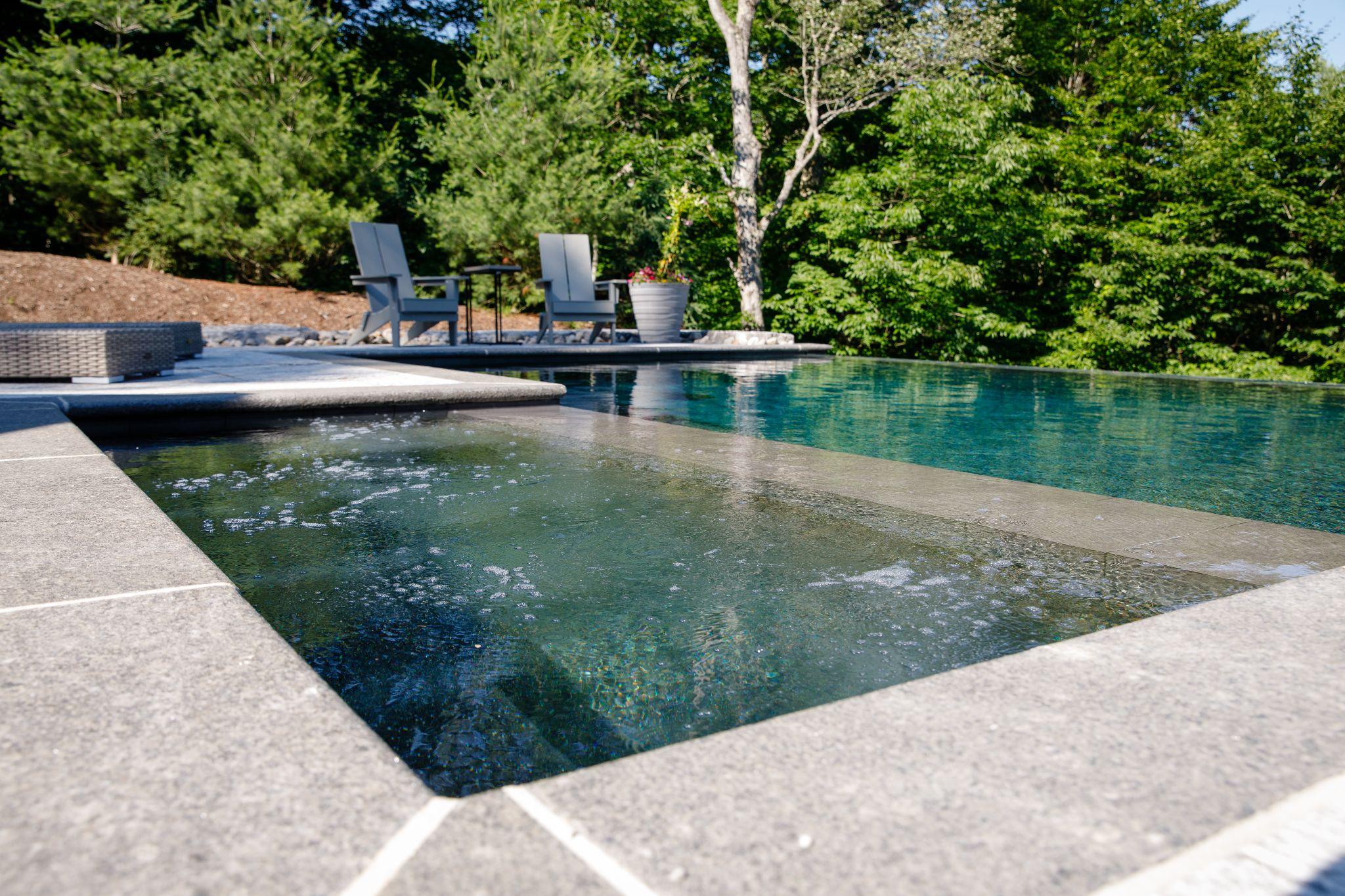
- BioGuard STINGY STICKS – The convenient use of these slow and evenly dissolving compressed stabilized chlorinating tablets makes them our most popular stabilized chlorine. It may be used effectively in skimmers, chlorinators and floaters – it is totally soluble with no residues and no gummy binders.
- BioGuard SMART STICKS – This product is unique because the erosion rate slows down when the pump is turned off. This makes this product last longer, especially when used in skimmer applications.
- BioGuard Tabgard PUCKS – Our economical chlorinating product
5. SANITIZERS - BROMINE

Ideal bromine residual range: 2.0 - 4.0 ppm
Bromine, the most common alternative to chlorine, is more stable than chlorine at higher water temperatures. Also the bromine sanitation efficiency is independent of pH. This explains why bromine is an overwhelming choice for use in spas and hot tubs.
Maintaining the Total Bromine level at 2 ‑ 4 ppm in the water, you will notice a less offensive odor than chlorine, making it ideal for an indoor pool environment. Bromine is unstabilized (it cannot be protected by cyanuric acid) and is susceptible to the UV rays of the sun; but Bromine actually lasts longer in the water under the same UV exposure when compared to Unstabilized Chlorine. Bromine actually has superior algae killing characteristics when compared to the same level of Free Available Chlorine. The drawback is that bromine demands more care in its application.
Bromine will sanitize and disinfect pool water, but it will not oxidize. Bromine itself does not have the ability to oxidize. In other words, by itself it cannot combine with bacteria, living organisms, ammonia or other contaminants to kill these invaders. Since bromine itself cannot oxidize, it needs a helper. That helper is often chlorine. The mixture of bromine is typically close to 61 % bromine, 27 % chlorine, and 12 % other ingredients.
Like chlorine, the bromine level must be continually monitored due to climate (temperature, humidity, sunlight, rain and wind) and bather load (extent of use), as well as the constant introduction and reintroduction of bacteria, living organisms, ammonia and other contaminants into your pool. This is why bromine levels must often be tested and adjusted; weekly under normal conditions and normal use and 2 to 3 times per week during periods of scorching temperatures, unbearable humidity and direct sunlight, as well as after any rainfall, winds, or heavy bather loads. This is also why you must shock the pool water regularly. The pH value of bromine is 4.0, which is very acidic. Therefore, do not place bromine in the skimmer basket.
BioGuard BROMINATING TABLETS ‑ 61 % available Bromine – 27 % available Chlorine
BioGuard BROMO BRIX (briquettes) ‑ 39.2 % available Bromine – 44.4 % available Chlorine
THE UNIQUE ASPECTS OF BROMINE CHEMISTRY
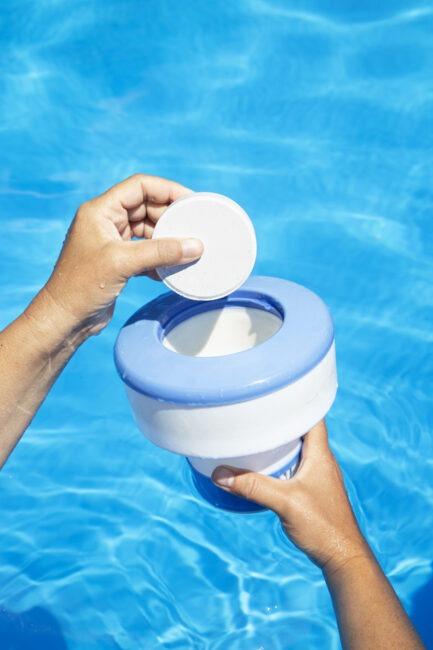
- The unique aspect of Bromine chemistry is that as the free bromine (hypobromous acid) becomes depleted during sanitation it reverts to inactive bromine – bromide ion (Br‑). The concentration of the bromide ion is called the BROMIDE BANK and (unlike with chlorine) has further sanitizing potential. The bromide bank can be reactivated to the active sanitizer (hypobromous acid) by free chlorine. Therefore, active chlorine will always sacrifice itself to regenerate active bromine in the presence of a bromide bank. This means that in a pool that has been on bromine for awhile and is switched to chlorine sanitization, the added chlorine will only keep reactivating the established bromide bank. Thus, unless the pool is completely drained to remove all of the bromide ion, once a bromine pool – always a bromine pool!
- Ammonia and bromine combine to form BROMAMINES (or COMBINED BROMINE). Bromamines will remain in the water and will register as bromine, but contrary to chloramines are still effective at sanitizing with no odor or irritation. Bromamines are not destroyed by any “breakpoint” procedure, but self decompose.
- The sole purpose of shocking a bromine pool is to cleanse the pool of bather organics and dirt as there is no “breakpoint” phenomenon in bromine sanitation. Since bromine tablets are slow dissolving they cannot be used for shocking a pool. Only a chlorine or non‑chlorine oxidizer is used.
- Bromine will be destroyed by sunlight, as it cannot be protected by Cyanuric Acid and there is no known stabilizer to protect bromine from the destruction by UV rays. So even active bromine will escape from pool water on a sunny day if unused, however this will not happen as fast as with unstabilized chlorine but faster than stabilized chlorine.
- Bromine sanitizer efficiency is essentially independent of pH in pool water, while opposite is true of chlorine. Free bromine (hypobromous acid) loses little sanitation ability with increasing pH. At a pH level of 8.0 bromine in your pool is still 83 % effective in killing bacteria.
SHOCKING OF BROMINE POOLS
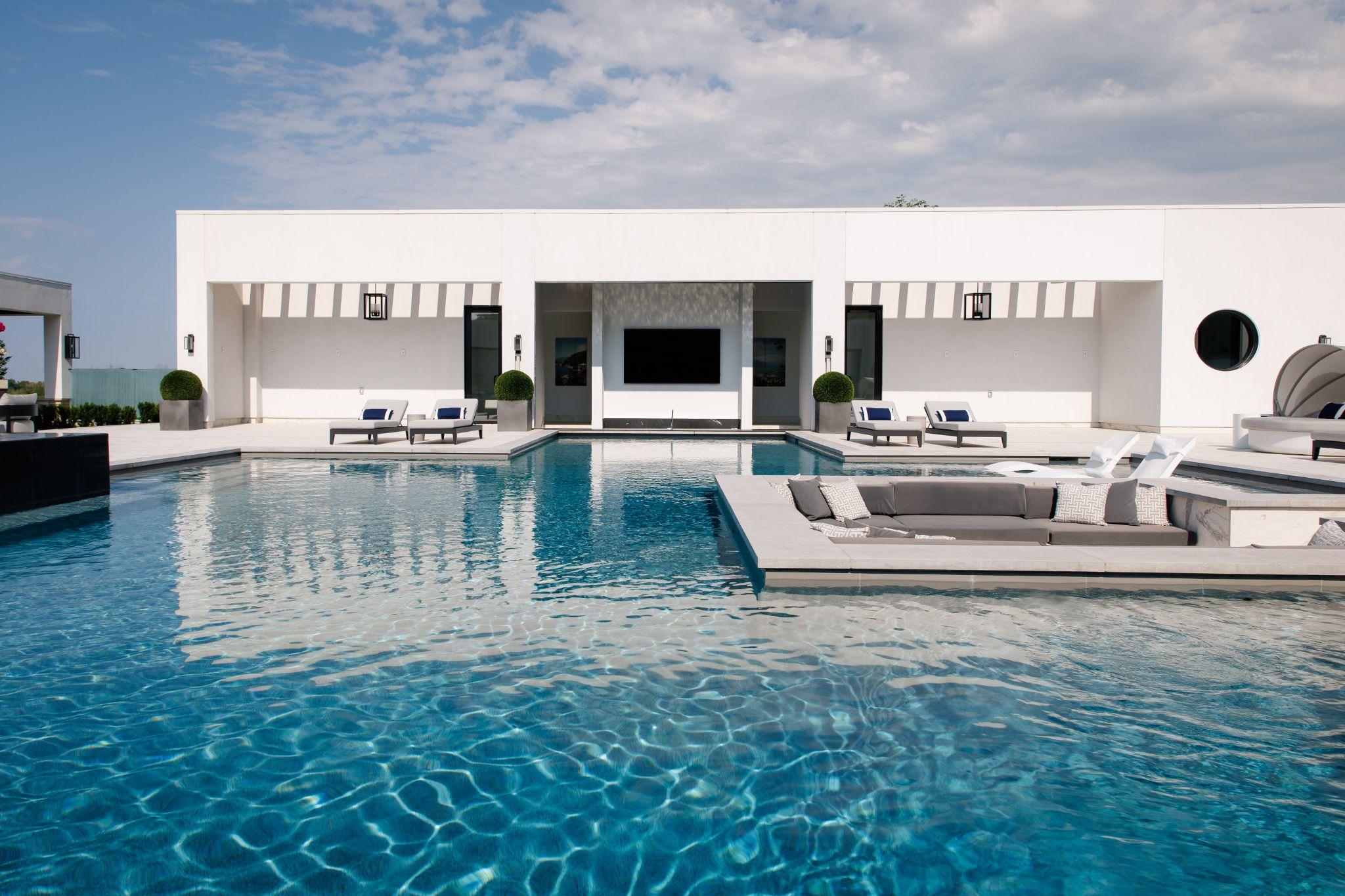
To shock a bromine pool you can use either a chlorine or non‑chlorine oxidizer.
BioGuard OXYSHEEN Potassium Peroxymonosulfate, is sold as “non chlorine shock”, is typically used with Bromine – the most popular alternative to chlorine. Once added, non‑chlorine shock will oxidize the ammonia, while at the same time reactivating the existing bromine in the water, allowing it to continue its job of sanitizing and disinfecting. Perhaps the best benefit of using non‑chlorine shock is that swimming can resume 15 minutes after its addition into the pool. Non‑chlorine shock can also be used in a chlorine pool, but it will only oxidize ammonia. It will not reactivate the existing chlorine in the pool, so it is ineffective at sanitizing and disinfecting.
6. OXIDIZING - SHOCKING

In contrast to stabilized chlorine-sodium, calcium and lithium hypochlorites do not contain any stabilizer and are therefore called unstabilized chlorines. These chlorines are best used for shocking your pool. In an outdoor pool, superchlorination’s prime purpose is to cleanse the pool. Contamination from dust, trees, air, etc., is quite severe, and the pool needs to be periodically shocked. The pool should be shocked:
- After a rain or windstorm
- During a hot spell
- Usually, once a week for general cleanliness
Superchlorination (or shocking) should occur at dusk to minimize sunlight destruction of chlorine. By shocking during a sunny day, the depletion of chlorine by the sun will take away some of its effectiveness. Shocking frequency will vary due to the climate (primarily the temperature, humidity and sunlight) and due to the bather load (the extent to which the pool is used, how many people use the pool at once, how many times throughout one day the pool is used, and how many days each week the pool is used). It only makes sense that you will have to shock the pool more often when it is hot, humid and sunny.
- BioGuard LITE® – Is the ideal oxidizing clarifier that can be used every week in any type of pool. Not only does BioGuard Lite® enhance oxidation properties and provides an additional clarifier and water buffering agent, and swimmers can return to the water in 15 minutes.
- BioGuard BP 35 and BioGuard BURN OUT 35 ‑ Lithium Hypochlorite [LiOCl] – ACC 35 %
It will quickly dissolve in water at normal pool temperatures without clouding the water or bleaching liners. It is also safe to handle. This product is designed for all pool types and does not affect calcium hardness. - BioGuard BIO‑CL and BioGuard BURN OUT ‑ Calcium Hypochlorite [Ca(OCl)₂] – ACC 65 %
When adding calcium hypochlorite to a vinyl pool or in pools with grey or black marbelite, it must be predissolved thoroughly in a pail of water and then poured in random areas of the pool to avoid bleaching of the liner and “bleaching” of marbelite surfaces can be easily handled. Since it dissolves slowly, the granules will not dilute before they fall to the pool floor. If not diluted, these highly available chlorine granules could bleach your non‑white pool floor. When used, it causes pool cloudiness and ph and Calcium levels to increase. - POOL LIQUID SHOCK—Sodium Hypochlorite [NaOCl]—ACC 10.3 %. While sodium hypochlorite is a very low-cost pool chlorine, the transportation of 90 % water comprises the hidden cost. Liquid pool shock is double the strength of laundry bleach, and you have to be careful handling this product. It is bulky, heavy, and dangerous to handle, and when applied, it will increase the pH of the pool water. Liquid shock can decompose quickly in storage.
7. PREVENTING ALGAE
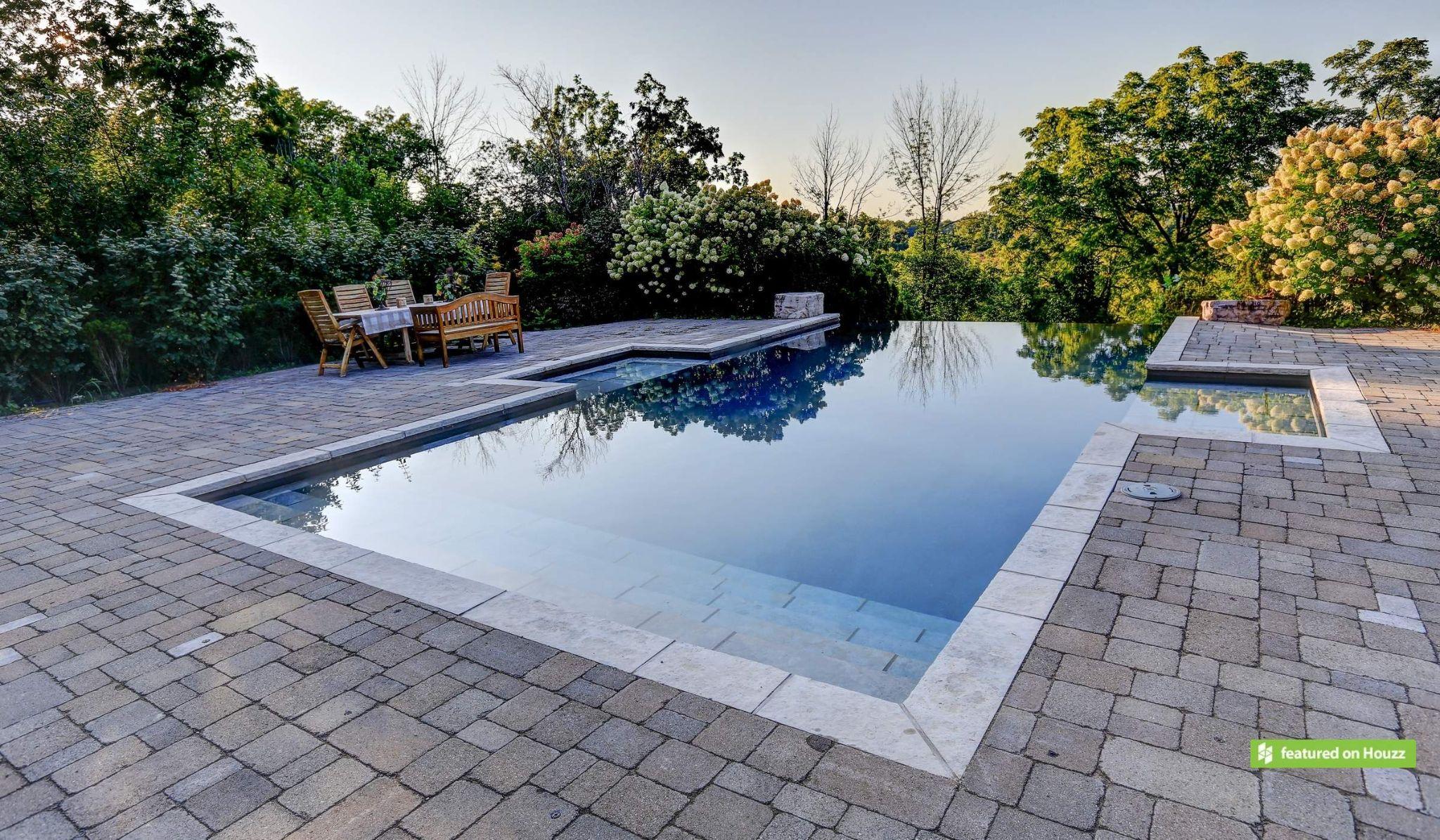
Algae can be a major concern for pool owners. Algae is a one‑celled plant that can grow in your pool if conditions (warm water, sunlight and carbon dioxide) are favourable. Algae is constantly brought to your pool from the tap water that is used to fill your pool. Microscopic algae spores carried by the wind or rainwater also account for algae growth. Other factors favour algae growth include limited water circulation, poor filtration, neglect of routine pool maintenance, heavy bather loads, neglect of overall water chemistry, insufficient chlorine (or its alternative), and neglect to shock. You can’t control the weather, but you can prevent these non‑weather conditions.
Always compensate for climate (sunlight and rain) and the bather load. Attention to these factors is your best defence in preventing algae.
There are three types commonly found in pools: green algae, mustard algae and black algae. Each type of algae requires its own treatment. This includes an algaecide, heavy doses of shock and regular brushing. Some environmental factors come into play and assist with the growth of algae.
Although low chlorine level is a significant cause, it is not the single contributing factor. However, a properly maintained sanitizer level, at 1‑3 ppm for chlorine and 2‑4 ppm for bromine, is your best algaecide (algae‑killer) and algaestat (algae‑preventive). When the sanitizer levels are allowed to drop or deplete, algae seeds will germinate. Within 12 hours, a pool can be completely inundated with green algae. This condition is called an algal bloom.
Make sure that you treat the algae. Too many pool owners hold off on any treatment until they are certain it’s algae. By this time, there may have been an algae bloom, infesting some or all of the pool. If you think algae may be forming, immediately brush the entire pool and add shock, regardless of when you last shocked. Many times, brushing and shocking are all that is ever needed to prevent algae. Green algae bloom can be destroyed by superchlorination with 30 ppm of free chlorine.
Although algaecide is credited with killing algae, it is virtually ineffective without chlorine (or its alternative), shocking, brushing, continual water circulation, and proper filtration. Algaecides are chemicals added to pool water to control algae. While algaecides can kill algae at high dosages, most are utilized to prevent algae formation when chlorine is allowed to become depleted. They are your best insurance against improper chlorination.
BioGuard POLYGARD ‑ the solution to helping prevent algae problems that kills ALL swimming pool algae with a patented non‑staining, non‑foaming formula. You can shock while using Polygard, so the pool is ready for swimming.
BioGuard BACK‑UP ‑ This is BioGuard®’s most effective algae preventative with its powerful surfactant agent, which enables it to work in tiny cracks and crevices where algae starts.
8. POOL WATER PROBLEMS

In certain situations, and in certain regions, additional chemicals may need to be added to the pool water. These chemicals are not always added during routine pool maintenance. Rather, these chemicals could be used when needed.
CLOUDY WATER
Cloudy water is usually caused for three reasons:
- Poor filtration ‑ either the result of sporadic and insufficient water circulation or a dirty filter that needs to be cleaned. Improper filtration and circulation will always result in a constant battle against turbidity.
- Poor water chemistry ‑ low chlorine reading (or its alternative), neglect of shock, or a high reading in either pH, Alkalinity, or Hardness could result in cloudy water. Environmental factors and high bather loads can also cause cloudy water, as they place additional demands on the chemicals. Balance your pool water and/or shock the pool.
- Presence of millions of microscopic particles that are too small to be trapped by the filter and remain suspended in the pool. If circulation and filtration is adequate, and if water chemistry is in balance, then you will need to add a clarifier to your pool which will coagulate these particles into filterable size.
BioGuard POLYSHEEN ‑ This product is a water clarifier used to clear up cloudy water quickly. It works on small, suspended particles in the water by combining them into larger ones for easy removal by the filter, and so restores water to sparkling blue.
POOL SURFACE STAINING
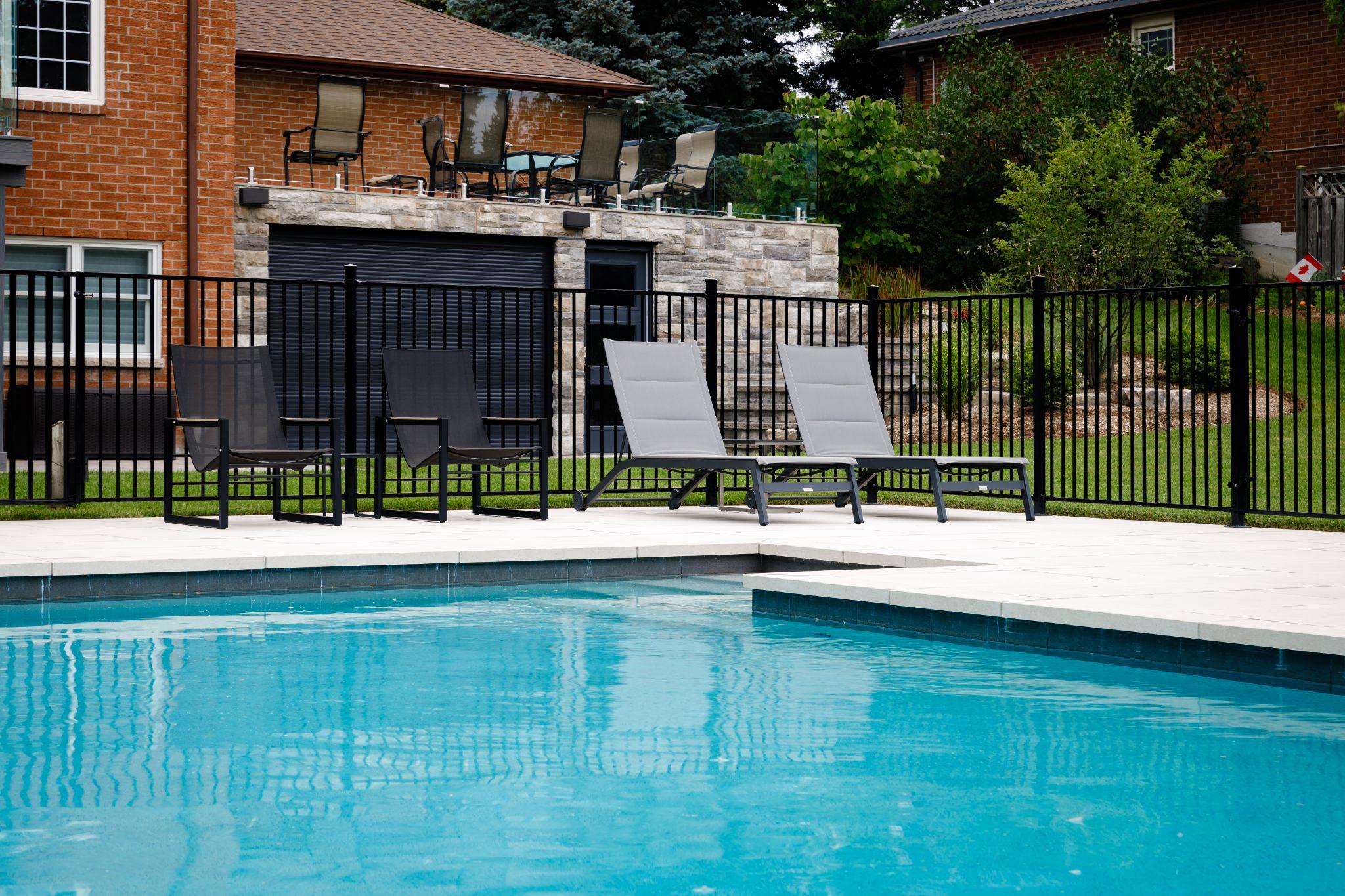
You will notice an odd tint to your pool water before you notice stains. You must respond to these early warning signals and treat the water chemistry before staining occurs. If all you see is an odd tint to the colour of your pool water, it is probably only the pH that needs to be adjusted. If stains occur, the pH is low, and either Alkalinity or Hardness or both are also low. These water balancers must be tested and adjusted into their respective ideal ranges. Begin with Alkalinity, followed by Hardness, and end with the pH. Also, you must rid the water of these stain‑causing minerals by adding a Metal Sequestering Agent (BioGuard POOL MAGNET). It will also help to brush any stained areas to assist with their removal. Stains on concrete pool walls are difficult to remove with stain control/removal products and might require acid washing.
BioGuard POOL MAGNET ‑ This powerful liquid metal sequestering agent chelates iron, copper, and manganese from your pool water. Removing these metals prevents staining and damage to the pool surfaces.
COLORED WATER
Excess minerals in the water will lead to discolorations and odd tints. There are some possible causes for the presence of excess minerals in the water:
- These minerals may have been present in the tap water used to fill your pool.
- Poor water chemistry will cause the water to dissolve metallic parts in your pool (walls, floor, handrails, ladders, light fixtures and equipment like the internals of the pump and heater).
- The use of a Metallic Algaecide, which contains copper. Although copper is superior at killing ANY type of algae, it is a very corrosive mineral.
The initial chemical to test and adjust when a green tint is present in the water is the chlorine level (or its alternative). If the chlorine level (or its alternative) is low, a green tint will occur. If this occurs, simply add more chlorine (or its alternative)—either manually or via an automatic chemical feeder—and shock the pool.
If the chlorine (or its alternative) is in range, then the green (or blue‑green) tint is due to copper in the pool water. Copper is not desired in pool water due to its corrosive nature. Typically, copper’s green (or blue‑green) tint is a direct correlation between acidic water (either low pH, or perhaps low Alkalinity and/or Hardness) and using a pool heater. To rid the pool water of the green (or blue‑green) tint, the pH or the Alkalinity and/or Hardness will have to be raised into their ideal range, and a Metal Sequestering Agent will need to be added.
A brownish red‑tint will appear if acidic water dissolves iron fixtures in your pool, and a brownish‑black tint will result from dissolving manganese. Both tints can also be treated with a metal sequestering agent.
SCALE

If an excessive amount of calcium is present in your pool water and the water is out of balance, typically either high pH, Alkalinity, Hardness, or a combination of any of the three, the calcium will be precipitated by either heat or evaporation. The calcium will then deposit itself as scale on the pool walls, floor, plumbing and equipment, causing equipment failure or replacement.
You must test and adjust the Alkalinity, Hardness, and pH ‑ in that order. It will also help to brush the scale from the pool walls and floor. If your calcium hardness level is too high, the only solution is to drain your pool at least partially and add soft water to dilute the calcium content.
BioGuard SCALE INHIBITOR ‑ This liquid anti‑nucleation agent assists in scale prevention by not allowing the calcium in the water to precipitate as scale on the pool surface and inside pipes and equipment, especially the heater.
WATER LINE

Products such as suntan lotion, underarm deodorant, women’s makeup and even body oils and dirt, can cause a water line, or a scum ring like in a dirty tub, to form at the water level. An effective treatment for scum rings is an Enzyme cleaner. An enzyme will break down any of these products, body oils, or dirt into their simplest form ‑ water. Initial foaming may occur after adding the enzyme. This foam is good. It is a sign that the enzyme is eliminating the scum ring and breaking it down into water.
EYE AND SKIN IRRITATION

- When your pH is out of balance, your eyes and skin will get irritated. The pH of your eyes is 7.5. If the pool water is higher or lower than the ideal range, irritation will occur. Check and adjust your pH.
- If your chlorine level is too high, you can add Sodium Thiosulfate to lower it. When you shock your pool (with a chlorine‑based shock), you add megadoses of chlorine. This will raise the chlorine level in your water, which will cause eye and skin irritation. Therefore, stay out of the pool for at least 8 hours after shocking.
- When ammonia (bather organics) is present, chlorine will combine to form chloramines, which will remain in the water and register as chlorine. Chloramines give pools that unpleasant chlorine odour and irritate eyes and skin. In this case, you need to shock your pool to get rid of them and restore bather comfort.
GREEN HAIR
Copper’s presence in your pool is a primary cause of green hair. A correlation between low pH readings and using a pool heater is a primary cause for green hair in light‑skinned blondes. For the pool, the treatment is easy ‑ raise and maintain the pH within its ideal range (7.2 ‑ 7.8) and add a Metal Sequestering Agent (BioGuard POOL MAGNET) to rid the water of copper. You must purchase a specially formulated shampoo for the light-skinned blonde to remove the green highlights.
FOAM
If products such as suntan lotion, deodorants, makeup, body oils, and dirt are allowed to build up, foaming may occur on the water. This is going to be a worry, especially if you have water features or a spa where foam can be created. Add an enzyme cleaner, and most of the foam will disappear after 1 to 2 hours. Using a defoamer can eliminate any foam instantly.
Another reason for foam is a low Hardness reading (under 100 ppm). If this is the case, raise the Hardness level by adding a Hardness Increaser (Calcium Chloride). Also, some types of cheaper algaecides will cause foam.
BioGuard ANTI‑FOAM ‑ Sometimes you might see foaming in your pool and especially in your spa water due to soft water, household cleaners used, shampoo and/or soap residues, an overdose of quat algicide, or filter cleaner that entered the pool. Anti‑Foam is designed to eliminate the foam instantly.
Master Your Pool Chemistry, Enjoy Crystal‑Clear Water
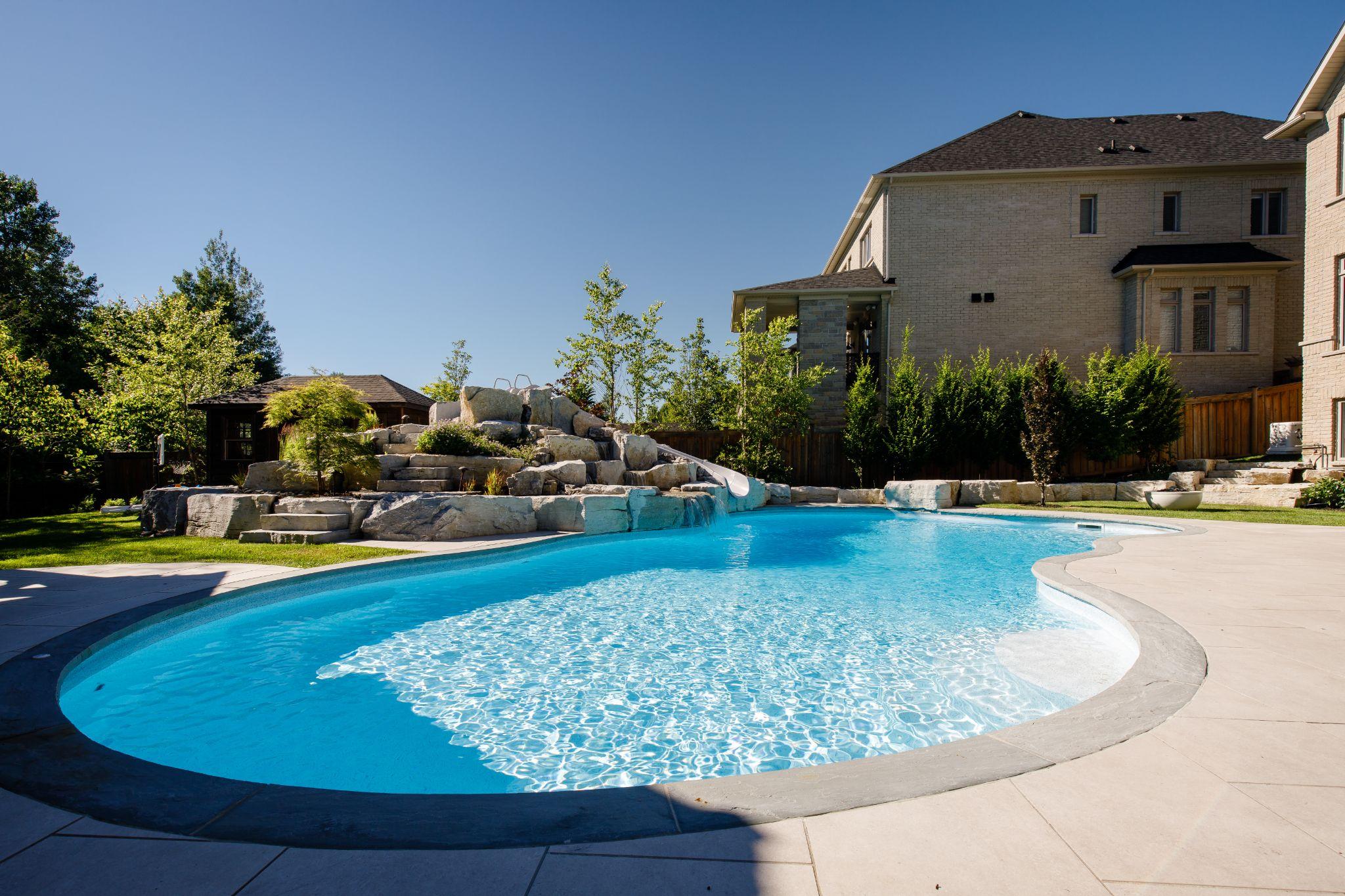
Keeping your pool pristine isn’t about memorizing every chemical term—it’s about understanding the few fundamentals that drive everything else:
- Balance first. Get pH, total alkalinity and calcium hardness in range; everything that follows (sanitizer efficiency, equipment life, swimmer comfort) depends on it.
- Sanitize smart. Whether you choose chlorine or bromine, hold the recommended residuals and shock on schedule to destroy organics and stubborn chloramines or bromamines.
- Protect your investment. Scale, stains, algae and cloudy water all trace back to neglected chemistry or circulation. A five‑minute weekly test—and the right corrective dose—costs far less than a drained pool or new heater.
- Adapt to the real world. Sunlight, storms, heat waves and heavy swim parties each place fresh demands on sanitizer and oxidation. When usage or weather spikes, so should your testing and shocking routine.
When you stay ahead of problems, the payoff is obvious: sparkling blue water 24 / 7, healthier swimmers and equipment that lasts seasons longer.
Need a hand dialing in your numbers, choosing the right shock, or tackling a stubborn stain? Our pool‑care team is here to help—so you can spend more time swimming and less time skimming test strips. Dive in with confidence!
